Science & Technology - 2016
November
Dante Upgrade Sheds ‘Light’ on Hohlraum Temperatures
Ultrathin Polymer Film Wins R&D 100 Award
Coming to Grips with Chaotic Plasma Behavior
Plasmas are turbulent mixtures of ions and free electrons formed at high temperatures when electrons are stripped from neutral atoms. Often called the “fourth state of matter” because their unique physical properties distinguish them from solids, liquids and gases, plasmas occur throughout the universe—in neon signs and lightning bolts, in the sun and the stars, and inside NIF targets as they’re heated by NIF’s 192 powerful laser beams.
When NIF’s beams interact with the plasma in a target, some of their energy can be lost through scattering or be transferred to other beams; if not controlled, these factors can cause asymmetries and instabilities that can interfere with implosion performance. 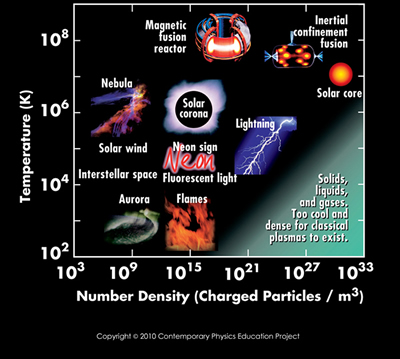 Different types of plasmas exist at different densities and temperatures. The hot, dense plasmas created at NIF are in the upper right. Extreme concentrations of energy are needed to create plasmas like this. Thus an important key to improving the performance of NIF inertial confinement fusion (ICF) and high energy density (HED) implosions is enhancing scientific understanding of the chaotic behavior of plasmas.
Different types of plasmas exist at different densities and temperatures. The hot, dense plasmas created at NIF are in the upper right. Extreme concentrations of energy are needed to create plasmas like this. Thus an important key to improving the performance of NIF inertial confinement fusion (ICF) and high energy density (HED) implosions is enhancing scientific understanding of the chaotic behavior of plasmas.
To gain a better understanding of the many complex processes occurring in plasmas, LLNL researchers use sophisticated simulations running on the Laboratory’s state-of-the-art supercomputers. The computational models provide insights into laser-plasma interactions, hydrodynamic instabilities, plasma transport processes, and other factors that can affect NIF experiments.
One code that has been especially useful for studying physical processes that are relevant to NIF experiments is a massively parallel molecular dynamics code called ddcMD, short for “domain decomposition molecular dynamics.” Heather Whitley, a Design Physics Division group leader in LLNL’s Weapons and Complex Integration Directorate, said the relationship between the ddcMD code and NIF experiments is a prime example of the synergistic partnership between NIF and the Laboratory’s high-performance computers: NIF experiments enable integrated physics experiments that are sensitive to the plasma transport coefficients computed using ddcMD.
In the past, ddcMD has been used to compute characteristic plasma properties such as diffusivity, electrical and thermal conductivity, viscosity, electron-ion temperature equilibration rates, stopping power (energy loss of a particle beam due to the interaction of beam particles with those of the target), microfield effects, continuum lowering (depression or “lowering” on the ionization potential), and mixed-plasma equation of state.
In recent years, Whitley said, “ddcMD has been applied more directly to modeling dynamic processes that we believe are relevant to understanding the physics of ignition capsules and HED experiments at NIF. Due to the short time scales and small dimensions involved in many NIF experiments,” she said, “understanding the details of collisional processes—so-called ‘microphysics’—is often important to understanding discrepancies between observed data and simulation(s) of NIF experiments using radiation-hydrodynamic codes.”
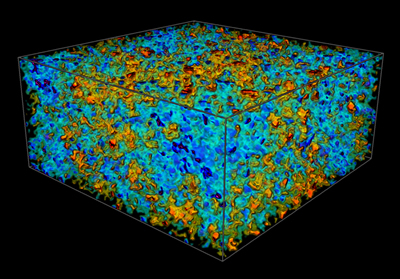 Visualization of the electron potential in a 140-million-particle molecular dynamics simulation of a hot, dense plasma using the ddcMD code on LLNL’s ASC Sequoia supercomputer.
Visualization of the electron potential in a 140-million-particle molecular dynamics simulation of a hot, dense plasma using the ddcMD code on LLNL’s ASC Sequoia supercomputer. On short time scales, Whitley said, the assumption of local thermodynamic equilibrium, or LTE, within a specific length scale can break down. These short time scale/small length scale phenomena are known as “kinetic effects.” The results of several current studies indicate that kinetic effects such as species separation (when deuterium ions race ahead of tritium ions in an ICF implosion due to mass difference) may be critical factors in modeling NIF experiments.
“Conventional calculations of the transport properties make use of kinetic theory with approximations for the collision physics,” added LLNL physicist Robert Rudd. “The resulting formulas contain a factor known as the Coulomb logarithm that either ignores or does not fully account for correlations in the positions of the ions in the plasma.” These correlations become more important as the strength of the plasma coupling—the interaction energy of particles in the plasma compared to their kinetic energies—increases.
Solving particle trajectories based on MD simulations is computationally much more expensive than calculations based on kinetic theory, Rudd said, so having an efficient code such as ddcMD that performs well on parallel supercomputers is invaluable.
Other research conducted at LLNL and Los Alamos National Laboratory (LANL) used the ddcMD code to directly study species diffusion and mixing at an interface (for example, a glow discharge polymer (GDP)-deuterium/tritium interface). “These simulations enable researchers to examine possible differences between the hydrodynamic codes and a full many-body (dynamic) simulation,” Whitley said, “which should lead to a better understanding of how the hydrodynamic codes may be revised to better model NIF experiments.”
Developing the Code
The ddcMD code was originally developed by LLNL’s Jim Glosli to simulate solids and liquids. It was designed to implement molecular dynamics with a robust decomposition of a system across parallel processors on a supercomputer.
In 2008, ddcMD’s use was extended to plasma simulations conducted by the Cimarron Project, a Laboratory Directed Research and Development (LDRD) project led by the Laboratory’s Frank Graziani. The researchers explored the use of virtual plasma simulations to predict and measure the properties of dense plasmas (see “Taming the Wild Frontiers of Plasma Science,” Science & Technology Review, July/August 2016).
Researcher Paul Grabowski went from the study of classical molecular dynamics to his current support of experiments on NIF. “I focused on understanding the stopping power of projectiles in plasmas,” he said. “This started with the direct comparison of MD simulations done by Mike Surh (of LLNL) with my own calculations using classical kinetic collision theory. We learned about the physics of strong scattering, dynamic response, and strong Coulomb coupling.”
NIF experiments create real quantum plasmas, which Grabowski now uses to benchmark stopping power theories instead of using classical molecular dynamics. NIF enables researchers to access the high energy density regime and precisely measure stopping power in warm dense matter (see “Measurement of Charged-Particle Stopping in Warm Dense Plasma”).
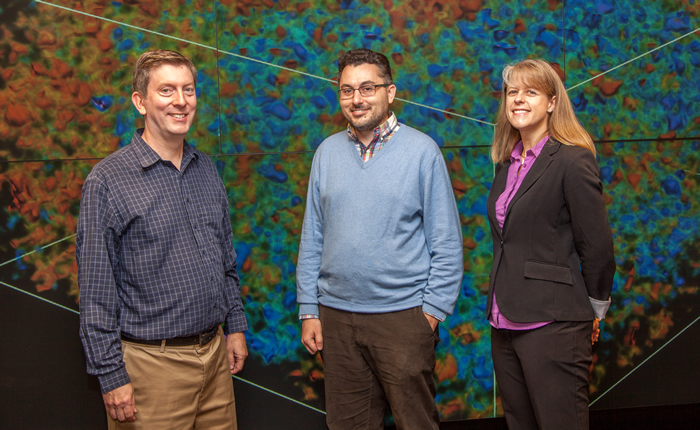 LLNL plasma researchers Rob Rudd, Paul Grabowski, and Heather Whitley. Credit: Clayton Dahlen
LLNL plasma researchers Rob Rudd, Paul Grabowski, and Heather Whitley. Credit: Clayton Dahlen “Perhaps the greatest impact that the Cimarron Project had,” Grabowski said, “is the spreading of the idea that many key quantities, including plasma-transport coefficients needed for hydrodynamic simulations of inertial fusion experiments, can be calculated from first principles. We employed a mixture of (MD) simulations, kinetic collision theory, and density functional theory to learn the detailed microphysics of these complicated systems. A common challenge to microphysics theorists is how to distill all of this knowledge down to simple expressions that can be used in larger-scale simulations.”
The Cimarron Project and subsequent research using the ddcMD code enabled researchers to better understand the physics of dense plasmas and deal more efficiently with the many dynamic time scales inherent in fusion plasmas.
“The molecular dynamics capability enables us to go beyond the mean field and binary collision approximations that are made in many standard plasma physics models by incorporating all interactions between all the particles in a system explicitly,” Whitley said. “These studies have helped to improve our understanding of how and when the standard approximations fail and have motivated the incorporation of new models for the transport coefficients into hydrodynamic codes, such as Miranda and HYDRA.”
The ddcMD code developers now are working with LLNL’s Center for High Energy Density Science to create new methods of using ddcMD to provide insight into plasma experiments conducted at NIF and other facilities, such as the Linac Coherent Light Source at the SLAC National Accelerator Laboratory.
Dante Upgrade Sheds ‘Light’ on Hohlraum Temperatures
A recent upgrade of NIF’s workhorse Dante x-ray diagnostic is helping researchers gain a better understanding of the temperatures produced in NIF hohlraums. When heated by NIF’s laser beams, the hohlraum can reach temperatures in excess of three million degrees and glow beyond white-hot, producing x rays which can be used for a wide variety of physics experiments.  A NIF hohlraum showing the beams entering the hohlraum through the holes on each end, striking the inner wall and generating x rays. The Dante diagnostic measures some of the x rays escaping through the entrance holes. Accurately measuring how bright the hohlraum glows is critical to improving researchers’ understanding of nearly every NIF experiment.
A NIF hohlraum showing the beams entering the hohlraum through the holes on each end, striking the inner wall and generating x rays. The Dante diagnostic measures some of the x rays escaping through the entrance holes. Accurately measuring how bright the hohlraum glows is critical to improving researchers’ understanding of nearly every NIF experiment.
The Dante upgrade involved the installation of new state-of-the-art, high-speed digital oscilloscopes that replaced aging recording hardware from the era of underground nuclear testing—adding flexibility, improving measurement accuracy, and reducing maintenance costs. In addition to modernizing the recording system, other enhancements enable more efficient operations and automated shot setup. The upgrades have significantly reduced the workload for shot operations staff and helped to reduce costs and increase the NIF shot rate.
The two Dante diagnostics, named after the 14th century Italian poet whose “Divine Comedy” describes a journey through the fiery inferno of Hell, looks deep into the inferno of the hohlraum (see “Dante: Measuring NIF’s Inferno”). Each Dante consists of 18 absolutely calibrated detectors, each of which is filtered using reflections from mirrors and transmission through different elements in order to measure only a certain energy range (or “color”) of x-rays. Combined, these signals provide a time history of the x-ray spectrum and temperature produced inside the hohlraum.
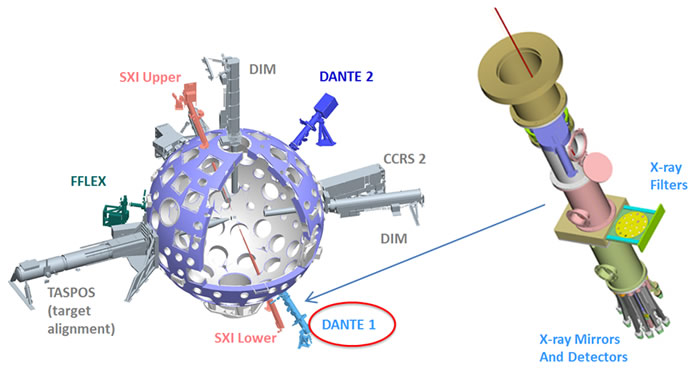 Dante 1 (or lower Dante) was the first of the two diagnostic systems to be upgraded. The Dantes look into the hohlraum through the upper and lower entrance holes. Dante 2 (the upper Dante) is scheduled to be upgraded during the June 2017 facility maintenance and reconfiguration period.
Dante 1 (or lower Dante) was the first of the two diagnostic systems to be upgraded. The Dantes look into the hohlraum through the upper and lower entrance holes. Dante 2 (the upper Dante) is scheduled to be upgraded during the June 2017 facility maintenance and reconfiguration period.Signals from each x-ray detector are transported on long cables from the Target Bay to the recording instruments on the diagnostic mezzanines. The thick concrete walls of the Target Bay, along with shielded cabinets, protect the delicate instruments from neutrons and gamma rays produced by the imploding target.
Not all potential hazards can be eliminated through shielding, however; if an x-ray filter breaks, for example, large voltages could travel down the normal signal path and damage the instruments. 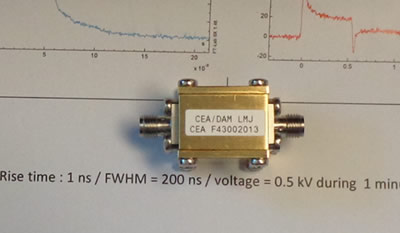 This protection circuit developed by researchers at the French Alternative Energies and Atomic Energy Commission (CEA) helps ensure that Dante’s modern digitizers can survive potentially damaging voltages present on the signal path from the x-ray diodes, without affecting the quality of the recorded data. To mitigate the potential for damage, special protection circuits that work like a very fast fuse, developed by NIF’s collaborators at the Laser Megajoule facility in France, were implemented in the upgraded design.
This protection circuit developed by researchers at the French Alternative Energies and Atomic Energy Commission (CEA) helps ensure that Dante’s modern digitizers can survive potentially damaging voltages present on the signal path from the x-ray diodes, without affecting the quality of the recorded data. To mitigate the potential for damage, special protection circuits that work like a very fast fuse, developed by NIF’s collaborators at the Laser Megajoule facility in France, were implemented in the upgraded design.
Ultimately the analog signals from the x-ray detectors are converted into digital format by the new oscilloscopes, which were developed by Keysight Technologies in Santa Clara, California. Each “’scope” is capable of recording four separate signals at 10 billion samples per second with a vertical resolution of about one in 1,000 (10 bits). Unlike their predecessors, the sensitivity of each channel can be remotely adjusted to match the expected signal level.
To accommodate the large range of hohlraum temperatures that NIF can produce, attenuation of the x-ray detector signal is an important element of the diagnostic. Remotely controllable attenuators have been introduced to streamline operation of the upgraded Dante; attenuation is now controlled directly by shot setup software. Previously, target diagnostic operators would have to manually insert individual attenuators into each of the 18 signal paths depending on shot expectations—a tedious and time-consuming task which had to be performed before nearly every NIF shot.
The former analog vacuum-tube oscilloscopes were at the end of their life cycle and were difficult and costly to maintain; replacements using similar technology would have cost about $1.6 million and still would have relied on analog technology. Going digital—incorporating time-saving enhancements while increasing reliability and signal recording quality—significantly reduced the cost. “Dante has gone from being one of the most expensive diagnostics to one of the more cost-effective diagnostics we run today on NIF,” said Perry Bell, program manager for Target Diagnostics.
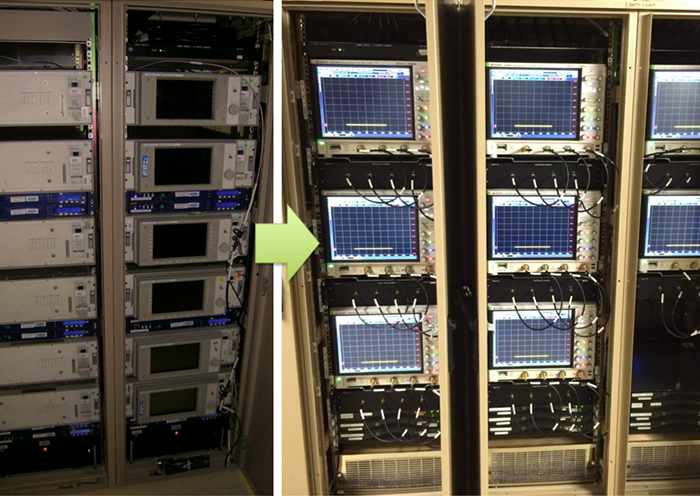 Dante’s analog oscilloscopes (left) have been replaced by modern Keysight ’scopes offering several performance enhancements including a much more stable time reference, adjustable sensitivity, and much longer record length. The eight Keysights on the right are doing the work of 20 of the old oscilloscopes.
Dante’s analog oscilloscopes (left) have been replaced by modern Keysight ’scopes offering several performance enhancements including a much more stable time reference, adjustable sensitivity, and much longer record length. The eight Keysights on the right are doing the work of 20 of the old oscilloscopes.Controlling the new hardware and incorporating the new functionality into the NIF Integrated Computer Control System (ICCS) was a large part of the project. Software engineers from across NIF’s software team redesigned the automated setup calculations for the 18 channels, rewrote shot participation rules, and developed new control and analysis code without affecting ongoing shots.
The upgrade was accomplished during a few weeks this summer; the old hardware was removed, the new hardware was installed, the new software was released, and Dante 1 entered the digital world—saving money, helping to increase the shot rate, and improving the quality of the scientific data being recorded.
Ultrathin Polymer Film Wins R&D 100 Award
The polyelectrolyte enabled liftoff (PEEL) technology, a method of fabricating freestanding polymer films such as those used to support NIF target capsules, has been named one of the top 100 industrial inventions worldwide for 2016 by R&D Magazine.

The magazine announced the winners of its annual awards, sometimes called the “Oscars of invention,” on Nov. 3 at the Gaylord Convention Center in Washington, D.C.; LLNL won a total of three awards. With this year’s results, the NIF & Photon Science Directorate and its predecessor, the Laser Programs directorate, have captured 63 R&D 100 awards out of a total of 158 won by the Laboratory since 1978.
PEEL is a robust, scalable method of fabricating freestanding polymer films that are larger, stronger and thinner than conventional methods can produce. It is used at NIF for the daily fabrication of membranes as thin as 30 nanometers that serve as compliant, load-bearing elements for laser targets.
With the new PEEL process, very thin films can be directly delaminated from their deposition substrates over very large areas. PEEL eliminates the need for often-used sacrificial interlayers, which can negatively impact the properties of the final freestanding film, and are difficult to scale in quantity and size. PEEL allows, for the first time, the remarkable properties of polymers such as polyvinyl fluoride (PVF) to be exploited in vanishingly thin films.
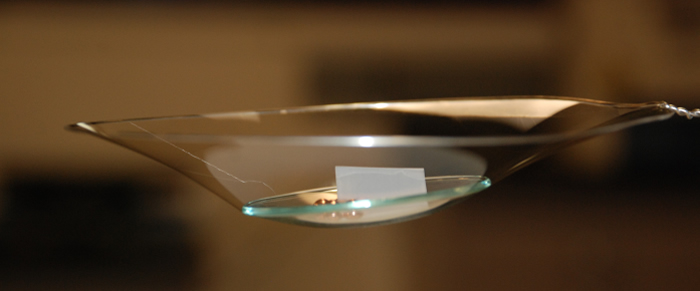 A 55-nanometer free-standing PEEL film supports a nine-gram watch glass more than 10,000 times the mass of the film.
A 55-nanometer free-standing PEEL film supports a nine-gram watch glass more than 10,000 times the mass of the film. Because the process is easily scalable in size and manufacturing quantity, it could eventually be applied to sensing, catalysis, filtration and wound-healing applications. The work, which received internal “seed money” from the Laboratory Directed Research and Development (LDRD) Program, was done by LLNL researchers Michael Stadermann, Salmaan Baxamusa, Philip Miller, Tayyab Suratwala, Chantel Aracne-Ruddle, and Art Nelson in collaboration with General Atomics researchers Anatolios Tambazidis and Kelly Youngblood; former LLNL summer students Maverick Chea and Shuaili Li; and former LLNL postdoc William Floyd.
For more information, see “NIF Ultrathin Polymer Film Is an R&D 100 Finalist.”




